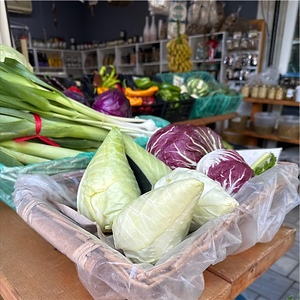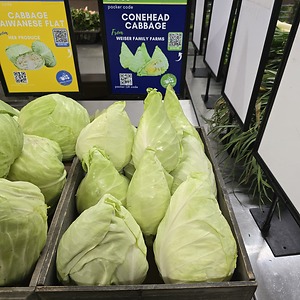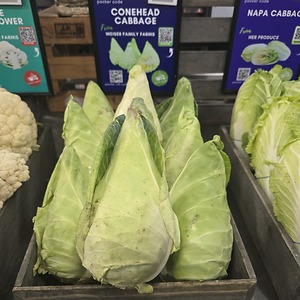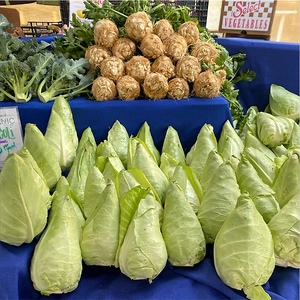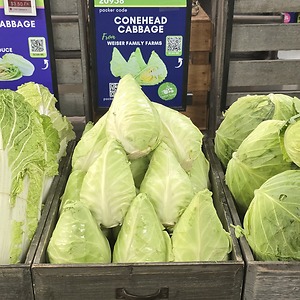


Green Conehead Cabbage
Estimated Inventory, head : 0
Description/Taste
Conehead cabbage is a leafy vegetable that grows in heads out of the ground. It has a rounded conical shape with a pointed top and a wider, curved bottom. This variety measures around 15 centimeters wide and 30 centimeters tall with an average weight of 1 to 2 kilograms, somewhat dense for its size. It has layers of green leaves that are tightly enveloped around each other. These leaves are broad, deeply veined, and bluntly pointed at the top, often transitioning from a darker to lighter green towards the bottom of the leaf. The inner leaves of the vegetable get progressively smaller, stiffer, and lighter in color. By the time they reach the heart of the cabbage, they achieve an almost white, light green hue. Conehead cabbage has a mildly sweet and cruciferous flavor with a distinctly crunchy yet tender texture.
Seasons/Availability
Conehead cabbage may be available from late spring to mid-fall.
Current Facts
Conehead cabbage is botanically known as Brassica oleracea and belongs to the Brassicaceae family, which also includes vegetables like broccoli, Brussels sprouts, cauliflower, collard greens, and kale. This variety goes by many names including Pointed cabbage, Arrowhead cabbage, Sugarloaf cabbage, and in California, Kool cabbage. It’s also referred to as Sweetheart cabbage because the French word for cabbage, chou, also refers to the nickname sweetheart. Conehead cabbage comes in both red-purple and green hues. Its hardy, early maturing nature allows it many culinary uses, from fresh eating to canning.
Nutritional Value
All cabbage varieties including Conehead contain vitamins A and B, preventing free radical cell damage and encouraging healthy vision and skin, immune function, cellular growth, metabolism, red blood cell formation, and energy, collagen, serotonin, and dopamine production. This vegetable is a source of riboflavin, helping to support the nervous system, mood regulation, iron metabolism, and eye health. It provides the body with iron, aiding in oxygen transportation, cognitive function, reproductive health, and hormone regulation and growth. Cabbage has fiber, bolstering digestion, gut health, blood sugar and cholesterol control, nutrient absorption, and elimination of toxins.
Applications
Conehead cabbage is served raw, cooked, steamed, roasted, or grilled. It can be substituted for Napa cabbage in Kimchi recipes and used as a replacement for any variety of cabbage, offering a sweeter flavor and more tender texture. This variety is popularly used for making sauerkraut or shredded into salads, which can be done starting at the pointed end and grating like cheese. When raw, this vegetable may be chopped up into slaw with carrots and red onions or rolled into a cabbage wrap with fresh herbs, peanut sauce, and grilled shrimp. It can serve as the main ingredient of a dish when caramelized in an iron skillet with garlic, coriander, cumin, red pepper flakes, and tomato paste, then finished with a topping of Greek yogurt. Conehead cabbage may be tossed into stir-fries, casseroles, soups, rice bowls, and curries. It can be incorporated into Mexican foods like tacos, burritos, and tostadas. This variety pairs well with bright citrus flavors, apples, vinegar, onions, mustard seeds, chiles, sausage, pork belly and shoulder, white fish, tofu, soy sauce, melting cheeses, and cashews. Store Conehead cabbage in the refrigerator for up to a week. Once sliced, it will last about 4 days.
Ethnic/Cultural Info
Filderkrau cabbage is a variation of Conehead cabbage that comes from Germany. It is often used in sauerkraut, a popular condiment made from fermenting cabbage in vinegar. Sauerkraut was likely first eaten by the ancient Romans and Greeks but has been consumed in Germany since the Middle Ages. Sailors brought this food on long voyages overseas because the vitamin C content in cabbage helped fight off scurvy, a disease that many fell ill to when traveling on ships. Filderkrau cabbage is also a common ingredient in Spaetzle, a unique noodle dish native to the Stuttgart region of Germany.
Geography/History
The exact origins of Conehead cabbage are not known, but this variety is most likely from Europe and has been cultivated for centuries in Germany, Austria, and the Netherlands. As Conehead cabbage was bred for colder regions of Europe, it naturally prefers a cool climate but also requires full sun exposure. It is a cultivated variety that is not sourced from the wild but is often sown in gardens or produced commercially. Conehead cabbage is a niche variety that is most popular in Northern and Central Europe, England, and Spain, where it may be found in farmers' markets and specialty stores. Within the United States, it is more popular among gardeners with an interest in heirloom vegetables and more likely to be purchased from seed and grown in home gardens than found in stores.
Recipe Ideas
Recipes that include Green Conehead Cabbage. One
| The Berryer |
|
Honey Orange Southwestern Cabbage Slaw |
| Chick in the Kitchen |
|
Grilled Arrowhead Cabbage |
| The Refuge Chef |
|
Beef Stroganoff & Cabbage Soup |







